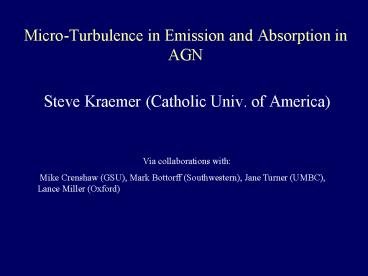Micro-Turbulence in Emission and Absorption in AGN PowerPoint PPT Presentation
Title: Micro-Turbulence in Emission and Absorption in AGN
1
Micro-Turbulence in Emission and Absorption in AGN
- Steve Kraemer (Catholic Univ. of America)
Via collaborations with Mike Crenshaw (GSU),
Mark Bottorff (Southwestern), Jane Turner (UMBC),
Lance Miller (Oxford)
2
Is Micro-Turbulence Present?
- Emission lines in AGN are broad. In Seyferts
galaxies, FWHM for optical UV Broad Lines lt
10,000 km/sec NLR lines lt 1000 km/sec - In general, widths decrease with distance from
the central source - In all cases, FWHM gtgt thermal ( few km/sec).
Possibilities - Superposition of knots with range in velocities.
- Micro-Turbulence
3
- Superposition likely. Central knots seen in
OIII with very large dispersions. - BLR emission lines are very smooth (e.g. Dietrich
et al. 1999). If thermal, need huge number within
light-days of central potential - Bottorff Ferland (2000) BLR clouds internally
turbulent. vturb gtgt vthermal - Note turbulence present in ISM. Larson (1981)
power-law correlation btw molecular cloud sizes
and line widths (see Elmegreen Scalo 2004) - Why not in AGN?
4
(No Transcript)
5
- Causes of turbulence in ISM
- Stars via winds and Supernovae
- Galactic rotation
- Gaseous self-gravity/cloud collapse
- Kelvin-Helmholtz and other fluid instabilities
- Fluid Mechanics
- convective acceleration time independent
acceleration of fluid w.r.t space - non-linear advection operator ? distortion of
velocity field
6
- Bottorff Ferland (2002) included dissipative
heating w/micro turbulence for BLR. With heating
rate Q - Q ?? ? (vturb 3 /D) ergs cm-3 s-1
- (vturb equivalent to b or 1/1.665 FWHM)
- We applied same formalism for NLR emission-line
gas
NV 1240, affected by photo-excitation heating,
NeV 3426 bossted by heating.
7
High resolution X-ray spectra of AGN show myriad
of soft X-ray emission lines arising in NLR
Ratios of resonance to forbidden lines in He-like
triplets can indicate temperature and density.
High r/f ratios collisionally excited gas (Ogle
et al. 2000) Photo-excitation (Sako et al. 2000
Kinkhabwala et al. 2002)/
8
Narrowness of Radiative Recombination Continua
suggests low Temps (Photo-ionization) ?
photo-excitation. But photo-excitation depends
strongly on vturb
Sim of OVII triplet, courtesy of R. Porter.
Cloudy models, (logU0), showing dependence of
r/f ratio on vturb and column density.
9
Is turbulence present in intrinsic
absorbers? Most readily answered using high-res
UV spectra of Type 1 Seyferts.
STIS spectra of NGC 5548, showing multiple
kinematic components in HI, NV, and CIV. Note the
difference in the profiles.
10
STIS spectra of NGC 3783 (Gabel et al. 2003),
showing variations in absorption over three
epochs, separated by 13 and 9 months. Radial
velocity changes or profile changes
(superposition of components)?
11
Comparison of FWHM and total H column densities
(derived from photo-ionization models) for
absorbers in NGC 3516, NGC 4051, NGC 4151, NGC
5548, and Mrk 509 (Crenshaw, in prep). Note even
smallest large column density absorbers have
super-thermal widths.
Slope of Nh to FWHM is 1.5. For Kolmogorov
cascade, slope is unity. Note slope is flatter
for the lower envelope. Combination of turbulence
and superposition?
12
If minimum widths due to turbulence, what would
we see? Two cases, logU-1.5, logNh20.5
FWHM 1000 km/s at face no decay. Profile
difference dominated by differences in ionic
columns and oscillator strengths.
FWHM 1000 km/s at face exponential decay.
Local value of vturb has strong effect.
13
- Conclusions? Perhaps open questions is better
term - Are emission lines enhanced by turbulence?
- Are smooth line profiles due to turbulence?
- How is the turbulence generated?
- Does turbulence damp out? If so , how and over
what scale lengths (see Mark Bottorff) - Is there associated dissipative heating?
- How does this affect cloud lifetimes,
acceleration, etc.

